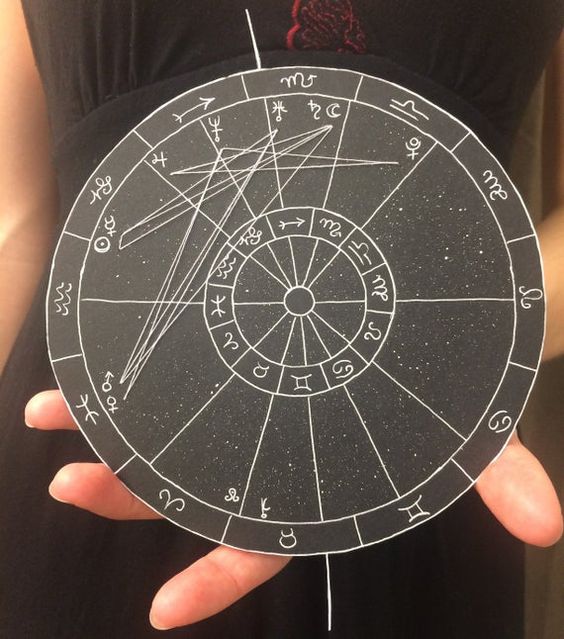
The Differences Between Synastry and Composite Charts!
 A synastry chart is an astrological tool that astrologers use to assess the compatibility between two individuals. It provides insights into how two people’s energies interact and influence each other, offering a deep dive into their relational dynamics. By comparing the positions of planets and other astrological points in each person’s birth chart, synastry explores the potential strengths and challenges of a relationship. The process involves overlaying one person’s natal chart over the other’s to identify where the planets of each chart sit in relation to one another. The angles or “aspects” these planets form with each other are important; they can be harmonious, promoting ease and support in the relationship, or challenging, indicating areas of conflict or growth.
A synastry chart is an astrological tool that astrologers use to assess the compatibility between two individuals. It provides insights into how two people’s energies interact and influence each other, offering a deep dive into their relational dynamics. By comparing the positions of planets and other astrological points in each person’s birth chart, synastry explores the potential strengths and challenges of a relationship. The process involves overlaying one person’s natal chart over the other’s to identify where the planets of each chart sit in relation to one another. The angles or “aspects” these planets form with each other are important; they can be harmonious, promoting ease and support in the relationship, or challenging, indicating areas of conflict or growth.
For example, a harmonious aspect like Venus conjunct Mars in a synastry chart might suggest strong romantic and sexual attraction, enhancing affection and compatibility. Conversely, a challenging aspect such as Mercury square Saturn could indicate difficulties in communication, where one person’s communication style or thought process may feel restricted or criticized by the other.
Using this holistic view helps couples understand their relationships more effectively, highlighting areas for potential ease or mutual support. A synastry chart does not determine destiny but illuminates the inherent energies at play.
The Underlying Forces Drawing Individuals Together
Synastry offers a look into why certain relationships seem predestined or irresistibly magnetic. It highlights the underlying forces that draw individuals towards each other, sometimes against all odds. It reveals the reasons for attractions and repulsions that define every human connection, explaining why we are often drawn to someone who appears significantly different from us or who complements aspects of ourselves that we may not fully express.
The examination of a synastry chart can quickly pinpoint the shared traits and stark contrasts between two individuals. However, it can’t tell whether their connection possesses the genuine chemistry necessary for a fulfilling relationship or if it’s likely to be a passing fascination. For instance, the placement of Venus in one person’s chart interacting with Mars in another’s can ignite an intense romantic and sexual attraction, often feeling like a magnetic pull towards each other. While the interaction of Venus and Mars in synastry can lead to intense attraction and chemistry, it can also be a source of conflict. Venus represents our values, pleasures, and what we find attractive. However, while Mars is associated with our drive, assertiveness, and the way we pursue what we want. When these two planets interact in a synastry chart, the relationship dynamics can become quite fiery and passionate—for better or for worse. The Venus-Mars aspect in synastry can lead to scenarios where romantic desires and attractions are strong, but they may clash with how each individual asserts themselves and pursues their desires. For example, if one person’s Venus forms a hard aspect (like a square or opposition) with another person’s Mars, it might manifest as an initial spark and strong physical attraction but could also result in frequent conflicts. These conflicts often arise from differences in how each person expresses affection and pursues their interests. One might be more aggressive or direct (Mars), while the other is more passive or values harmony (Venus).
These clashes often revolve around core issues like what each partner values and finds important, which can extend into deeper areas. Since Venus and Mars are deeply connected to personal values and self-expression, disagreements in these areas can be particularly intense and charged with emotion. However, these passionate disagreements can also be a source of growth and attraction in the relationship. They force each partner to confront and negotiate their desires and values, which can lead to a deeper understanding and respect for each other.
Opposites Attract
Moreover, the ideas of “opposites attract” often finds a basis in synastry through the examination of complementary differences. Sometimes, one person’s chart shows strengths where the other’s shows weaknesses, creating a balance or a sense of completion. Often creating a feeling of “filling in” what the other person lacks or cannot express themselves. This can lead to a deep emotional and psychological connection, as each partner intuitively understands and fulfills the other’s unspoken needs.
Through synastry, individuals may also discover potential challenges and learn how these can be managed or mitigated. Understanding these dynamics allows couples to make informed decisions about nurturing their relationship, recognizing their advantages while acknowledging and addressing the disadvantages.
A common paradox in relationships: attraction to qualities that initially seem complementary or desirable can, over time, lead to friction as the novelty wears off and the daily realities of those differences set in. The shift from attraction to potential conflict is often a theme in relationships. Each partner initially finds the other’s differing qualities intriguing or supportive.
An example:
A disorganized woman appreciates the structure her partner brings into her life, likely seeing it as a stabilizing force that compensates for her own chaos. Similarly, a fearful man finds his wife’s assertiveness and zest for adventure compelling, as it introduces excitement and bravery that he might feel he lacks. However, the very traits that attract them can become sources of tension. The organized partner’s desire for neatness and order, initially a boon, might start to feel like a constraint or a nagging criticism to someone who is naturally less structured. What begins as admiration can turn into a feeling of being controlled or misunderstood. Likewise, the assertive partner’s love for adventure can become a point of anxiety for a more risk-averse individual, especially if it pushes them beyond their comfort zones or leads to prolonged separations.
There is difference between being attracted to an “idea” of someone—a version that exists ideally in one’s mind—and dealing with the actuality of their full personality in day-to-day life. Partners may find that they need to continuously renegotiate their boundaries and expectations to accommodate both their initial attractions and the evolving realities of their personalities and needs. Synastry is not just about understanding compatibility but also the nature of interactions between two people’s charts.
Synastry: The Real Nature of a Relationship
Let’s dive a bit deeper into how aspects between Neptune and another person’s Sun might play out differently depending on that person’s own natal aspects.
When Neptune aspects another person’s Sun in synastry, it brings elements of idealization, inspiration, or confusion. Neptune is associated with dreams, illusions, and spirituality but also deception and disillusionment. How this influence manifests can vary significantly depending on other aspects in the charts.
Neptune Conjunct Sun: This aspect can create a strong bond where the Sun person feels understood at a soul level, but there’s a risk of disillusionment if the Neptune person fails to live up to the idealized image created by the Sun person.
Neptune Square Sun: Challenges in seeing each other clearly are common with this aspect. There might be misunderstandings or disappointments when the reality does not match the fantasy each has built around the other.
Neptune Trine or Sextile Sun: These softer aspects promote mutual understanding and an intuitive connection, making it easier to support each other’s dreams and ideals without the harsher disillusionments seen in the hard aspects.
Interactions with Natal Aspects
The impact of Neptune’s interaction with someone’s Sun also depends on that individual’s natal chart aspects:
Sun Conjunct Saturn: Individuals with this natal aspect value stability, structure, and reality. When Neptune aspects this combination in synastry, it might introduce a level of uncertainty or confusion that feels uncomfortable or unsettling. The Saturn influence seeks reliability, which Neptune’s foggy nature disrupts.
Sun Conjunct Jupiter: Those with Sun conjunct Jupiter in their natal chart tend to be optimistic, expansive, and confident. A Neptune aspect here might not be as destabilizing as with Sun-Saturn. Instead, Neptune might amplify Jupiter’s tendency toward excess or idealism. The challenge here would be a tendency to overestimate, overlook details, or be overly optimistic, potentially leading to impractical decisions in their relationship.
A couple with Neptune aspecting Sun, where one partner has a Sun-Jupiter conjunction, might need to be more mindful about not getting carried away with ungrounded plans or visions. Meanwhile, with a Sun-Saturn conjunction, it would be important to find ways to integrate Neptune’s creative and spiritual qualities without undermining the need for stability and realism. The art lies in balancing these energies: integrating Neptune’s idealism and spirituality with the Sun’s core identity, whether that identity is more structured (Saturn) or expansive (Jupiter).
Synastry involves a wealth of information about the interactions between the planets and how they align within the charts of two individuals. It delves into how these planetary placements interact, indicating the potential ease or challenges a couple might encounter in their relationship.
Composite Chart
The composite chart in astrology provides a fascinating contrast to synastry by offering a “third entity” perspective—the relationship itself, considered as a separate entity with its own astrological identity. This method is particularly useful in understanding the overarching themes, challenges, and strengths of a relationship, seen through the lens of astrological interpretation.
Nature of the Composite Chart
A composite chart is created by calculating the midpoints between corresponding planets and points from two individuals’ natal charts. For example, if one person’s Sun is at 10 degrees Aries and the other’s Sun is at 20 degrees Aries, the composite Sun would be at 15 degrees Aries. This midpoint method applies to all planets and significant points (like the Ascendant), thus creating a new chart that symbolically represents the relationship as a blend of both partners’ energies.
Interpretation and Significance
Composite Sun: Represents the core identity, primary purpose, or essence of the relationship. Where it falls (by house and sign) can show the main area where the relationship has the most influence or where its energy is most focused.
Composite Moon: Reflects the emotional tone and nurturing theme of the relationship. How the partners comfort each other and what makes the relationship feel secure can be seen through the placement of the composite Moon.
Composite Mercury: Indicates how the relationship communicates and processes information. It can show the intellectual connection between the partners and how they share ideas or resolve conflicts as a unit.
Composite Venus: Relates to love, affection, and attraction within the relationship. It can indicate what the relationship values and finds beautiful, as well as how partners express affection and enjoy leisure together.
Composite Mars: Describes the assertive and confrontational dynamics of the relationship. It can reveal how the relationship handles conflict, ambition, and action.
Growth and Transits
Just like individual natal charts, composite charts undergo transits and progressions. These can trigger events or periods of change within the relationship itself. Transits to the composite chart can activate certain potentials or challenges depicted in the chart and can mark important turning points or phases in the relationship’s development.
Practical Use
To fully appreciate the impact of a relationship on an individual’s life, one can analyze how the composite chart interacts with each person’s natal chart. For instance, if the composite Sun conjuncts one partner’s natal Venus, the relationship might bring great joy and creative fulfillment to that partner. Conversely, if the composite Mars squares another’s natal Mercury, it might indicate that the relationship brings about conflicts in communication or decision-making for that individual.
By comparing the composite chart to each person’s natal chart, individuals can gain insights into how the relationship influences their personal growth, challenges, and the parts of their lives most affected by the partnership. This analysis helps partners understand not only how they come together but also the independent impact the relationship has on each of them, providing a comprehensive view of the dynamics at play.
Understanding the Composite Sun
The Sun plays a pivotal role in a composite chart as it illuminates the core purpose, essence, and vitality of the relationship. The placement of the composite Sun, by sign and house, can reveal much about how the relationship manifests its energy and what areas it will most significantly influence.
By Sign: The Sun’s sign in the composite chart symbolizes the basic nature of the relationship’s combined personality traits and how the relationship expresses its identity. For example:
– A composite Sun in Aries may indicate a relationship that is dynamic, pioneering, and often initiates new ventures.
– A composite Sun in Libra might suggest a relationship that highly values harmony, balance, and partnership, emphasizing cooperation and diplomacy.
By House: The house placement of the composite Sun shows the primary area of life where the relationship has its greatest impact or where its energy is most focused. This can provide insights into where the relationship finds its expression and where it might face its most significant challenges or achievements. For instance:
– A composite Sun in the 4th house could indicate that the relationship heavily emphasizes the home, family, or emotional security.
– A composite Sun in the 10th house might focus on career, public status, or collective goals, suggesting that the relationship plays a significant role in how each partner is perceived publicly.
Sun’s Aspects
The aspects in composite charts, especially those involving the Sun, can reveal major “life themes” for the relationship itself.
The aspect between the Sun and Saturn in a composite chart brings a significant focus on the themes of responsibility, discipline, and limitation within the relationship. The energies of the Sun (identity, vital force) and Saturn (restriction, discipline) are blended. This can suggest a relationship with a serious tone, where duties and responsibilities are at the forefront. It might also indicate a relationship that matures slowly but offers substantial long-term rewards. The couple may face persistent obstacles that test their commitment and strength as a unit. These could be external pressures like financial limitations, career demands, or familial obligations. There could be a strong focus on long-term planning or career goals, which might overshadow more spontaneous or joyful expressions of the relationship. The relationship might provide a significant learning curve, where both individuals learn about their limits, endurance, and the value of hard work.
Individual Birth Charts and Coping Mechanisms
Understanding Individual Responses:
By examining how each person’s chart interacts with these composite aspects, you can understand their personal coping mechanisms and reactions. For instance, an individual with a natal Jupiter aspecting their Sun might naturally seek expansion and could feel particularly stifled by Saturn’s limiting energy in the composite chart. Consequently, they might feel trapped by the relationship itself.
Another partner might have a well-aspected Saturn in their natal chart, suggesting they are more comfortable with structure and discipline, thus potentially more equipped to handle the relationship’s Saturnine demands.
As another example of how to read aspects in a composite chart, take a look at Liz Greene’s Sun-Neptune aspect interpretation:
“Most powerful is a composite in which the Sun makes a strong aspect to Neptune, for then the essential goals and meaning of the relationship are coloured by Neptune’s longing for fusion and flight from the pain of the mortal world. Such relationships are often based on shared spiritual or artistic commitment. If this kind of container can be provided, darker Neptunian elements may not prove too great a problem. Where no such container exists, the relationship may require some form of abnegation which, with or without the consent of the individuals, denies the possibility of it being sustained in the world of form. Sometimes the relationship comes into being through shared guilt, or an obligation such as unplanned pregnancy. “ By Liz Greene, Neptune and the Quest for Redemption
Impact on Individual Natal Charts
When you place the composite chart’s Sun in relation to an individual’s natal chart, you can observe where and how the relationship’s energy influences that person. This can be done by noting which natal house the composite Sun falls into from the perspective of each partner’s chart. This interaction shows the sectors of life most affected by the relationship. For example:
– If the composite Sun falls into your 2nd house, the relationship might have a strong impact on your values, possessions, and financial matters.
– If it falls into your 7th house, it could significantly affect your approach to close partnerships, possibly enhancing your focus on serious relationships.
Analyzing Transits and Aspects
The aspects that the composite Sun makes with other planets in the composite chart and the transits it experiences can also indicate periods of growth, challenge, or transformation within the relationship. For example, if the transiting Saturn conjuncts the composite Sun, it may be a period of testing, responsibilities, and maturation for the relationship. Conversely, a trine from transiting Jupiter to the composite Sun might bring opportunities for expansion and joy.
Astrologer Liz Greene characterizes the composite chart as having a “curious fated vibe,” which gives it a deeper and somewhat mystical quality. Unlike synastry, which maps out the direct planetary interactions between two people, the composite chart synthesizes these interactions to form a unique, unified horoscope. This method reveals not just how partners affect each other but how the relationship itself operates as an independent entity.
The composite chart helps to identify the broader themes and core issues of the relationship, making it possible to see beyond the everyday interactions and into the underlying patterns that govern the partnership. The “fated vibe” may refer to the idea that the relationship follows a predestined path or purpose that might feel beyond the control of either partner. This could manifest in ways that neither anticipated before their union. For example, partners might find themselves thrust into situations or roles that neither had planned, yet which emerge from the synergy of their combined energies.
The composite chart shows how the energy of the relationship tends to manifest itself. For instance, a prominent Pluto in the composite chart could suggest transformative, intense experiences that force growth or changes within the relationship. Alternatively, a dominant Jupiter could indicate a relationship filled with optimism, shared adventures, and expansions, such as travel or educational pursuits together.
According to Penny Thronton,
The composite chart describes the actual experience of two people in a relationship. As such, it offers an immediate and clear idea of a couple’s interaction and the main areas under focus in the relationship. Certainly the other techniques of synastry already covered give valuable insights into relationships, but the composite puts it all together quickly and succinctly. The composite can be read in much the same way as the natal chart, but with one fundamental difference. In the composite, the planets and houses are the key factors for interpretation and not the signs. The planets as they are seen in composite are of course placed in the signs, but in effect they (the signs are just abstractions serving merely to measure the planetary positions. As this technique is still relatively new, perhaps, in time, the signs will be found to have a bearing on interpretation. Personally, I have not found them to be effective. The angular houses (1st, 4th, 7th, and 10th) are the most dynamic areas of the composite chart and in close personal relationships it is highly desirable to have any of these houses occupied. The 4th house is an especially sensitive area; home does not merely imply four walls that surround a couple but the sense of ‘being at home’ with each other. As with the I.C and the 4th house in a natal chart, in a composite chart, the roots of the relationships are found here with all the connotations of origins of past lives. The 5th and 11th houses also bode well for personal relationships. These two houses are happy, creative areas of the composite; the 11th house, which is synonymous with friendship is an essential factor for long-term relationships. Although the 5th house is allied to love affairs, many long-term relationships have a strong 5th house emphasis. The 2nd and 8th houses have much to do with feelings – emotional and sexual – and so are also very important for relationships such as marriage. The 6th and 12th houses seem to cause a variety of problems for couples when they are occupied (especially by the personal planets). Duty and responsibility are factors every couple undertakes in marriage, but these qualities can be over emphasized in a relationship when the planets are placed in these houses. The 6th/12th house axis may have karmic connotations, particualty when the Sun and Moon (or ruling planet or nodes) are present. In this case, the relationship is likely to be one of service, not only to each other, but out in the world. The 12th house can be trouble in composites, as planets found here frequently undermine the relationship itself.
COMPOSITE CHARTS
The interpretation of a composite chart follows a holistic approach much like that of an individual natal chart, but with the focus shifted from the individual to the relationship itself. The emphasis is on understanding how the combination of two people’s energies manifests as a singular, unified entity.
The Rising sign or Ascendant in the composite chart is particularly significant as it sets the tone for the entire chart, much like it does in an individual’s natal chart. It represents the relationship’s initial energy, how it begins, and how the couple presents themselves to the world. It can also influence first impressions, shaping how others see and react to the couple as a unit. For example, a composite Ascendant in Libra might suggest that the relationship is seen as harmonious and partnership-oriented, with an emphasis on balance and fairness. Conversely, a Scorpio Ascendant might give the relationship an intense, possibly secretive or deeply emotional facade.
The houses in a composite chart reveal where in life the energies of the relationship are most likely to manifest. They can point to realms of life that are emphasized or areas where the relationship has its greatest impact or faces its most significant challenges. The signs that the planets occupy in the composite chart help describe how the energies of the planets are expressed. They color the way the relationship functions and interacts with external forces. The signs can indicate the style in which the couple approaches various areas of their life together.
Delving into synastry and composite charts can be a deep and fascinating exploration, one that many people enjoy spending a lot of time unraveling. These charts offer insights into relationships that can be studied for years, continually revealing new revelations and insights as we grow and evolve in our connections with others. The differences between synastry and composite charts lie in their approaches: synastry focuses on the interaction between individual charts, while composite charts represent the relationship itself as a single entity. Both methods offer valuable perspectives on understanding the dynamics and potentials within relationships through the lens of astrology.


























 Venus-Pluto Synastry: A Love So Powerful That It Might Just Kill Them
Venus-Pluto Synastry: A Love So Powerful That It Might Just Kill Them
 The Pisces Woman
The Pisces Woman
 A Planet in the 8th House: Gets Into the Same Situations Over and Over. It Has to Do With Its Connection to the Dead!
A Planet in the 8th House: Gets Into the Same Situations Over and Over. It Has to Do With Its Connection to the Dead!
 Pluto-Sun Transits: What’s Changed?
Pluto-Sun Transits: What’s Changed?
 Pluto Transits the 8th House: Major Life-Altering Undertakings
Pluto Transits the 8th House: Major Life-Altering Undertakings
 Astrology Degrees and Meaning
Astrology Degrees and Meaning
 Mars-Pluto Synastry: Something Quite Dark and Dangerous
Mars-Pluto Synastry: Something Quite Dark and Dangerous
 Uranus Transits the 4th House: The Chaotic Path to Personal Inner Growth
Uranus Transits the 4th House: The Chaotic Path to Personal Inner Growth
 Pluto in Libra in the 2nd House: Lessons on Self-Worth and Financial Independence
Pluto in Libra in the 2nd House: Lessons on Self-Worth and Financial Independence
 South Node in Scorpio or 8th House
South Node in Scorpio or 8th House
 Pluto Transits the 1st House: What to Expect?
Pluto Transits the 1st House: What to Expect?
 Composite Sun in the 8th House: Weather the Storm
Composite Sun in the 8th House: Weather the Storm
 Venus Opposite Saturn
Venus Opposite Saturn
 Aquarius: What Does Consciousness Mean to Them?
Aquarius: What Does Consciousness Mean to Them?
 Uranus Transits: 1st House: Winds of Change:
Uranus Transits: 1st House: Winds of Change:
 Love’s Mirage: The Sun- Neptune Synastry Influence
Love’s Mirage: The Sun- Neptune Synastry Influence
 Moon-Saturn Synastry
Moon-Saturn Synastry
 Pluto in the 1st House: Body Language Tips (Gifs)
Pluto in the 1st House: Body Language Tips (Gifs)